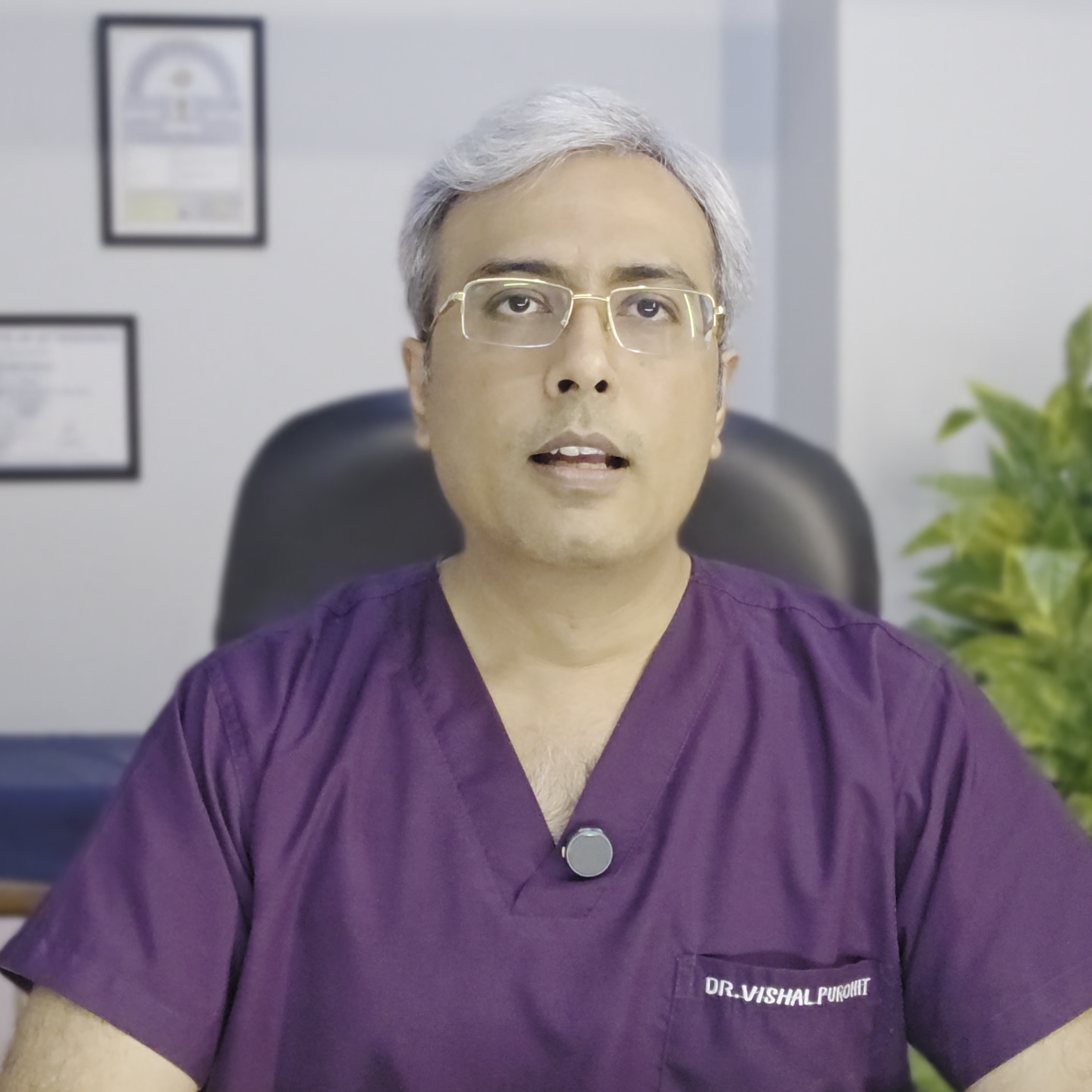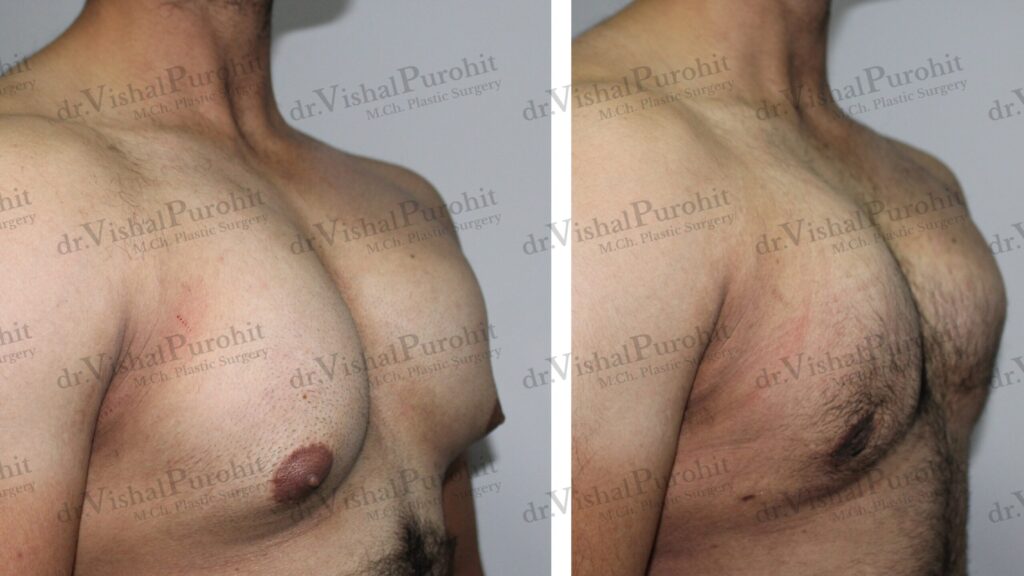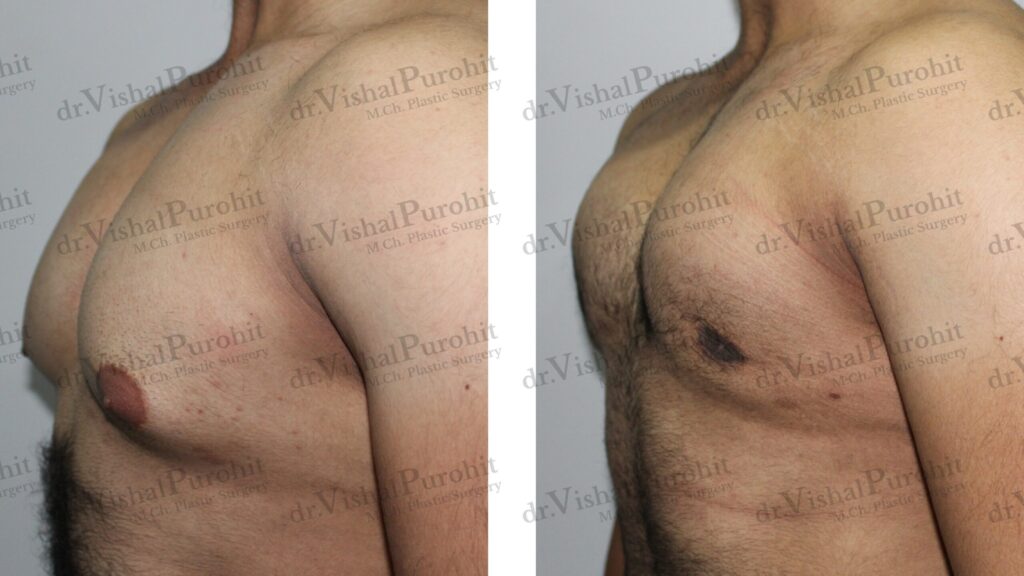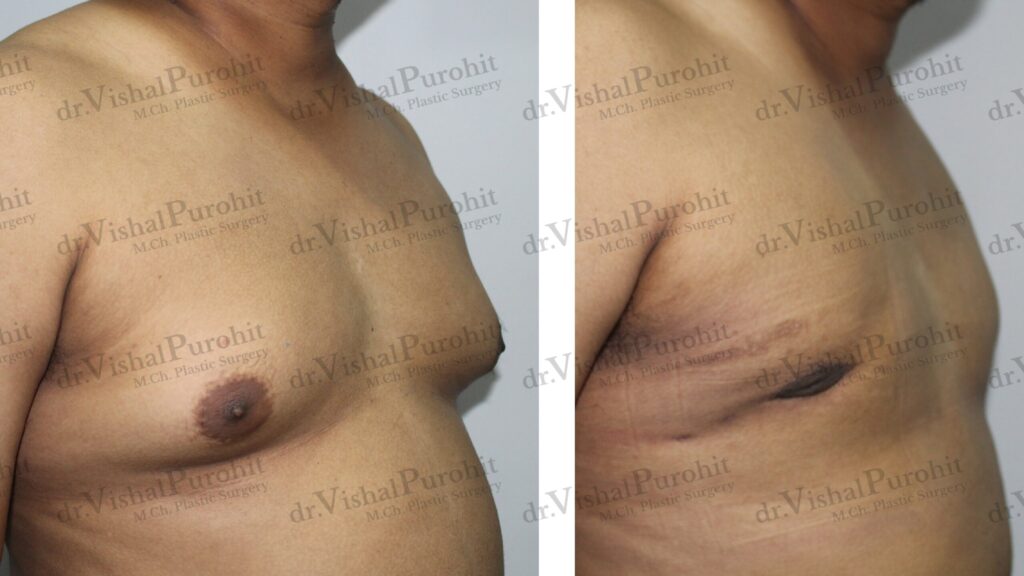Gynecomastia Surgery in Jaipur (Male Breast Reduction)
Restore a flatter, firmer, more masculine chest—safely and predictably.
I’m Dr. Vishal Purohit, a board-certified plastic & cosmetic surgeon in Jaipur with 10+ years of experience. This page explains what gynecomastia is, how surgery works, costs, recovery, and how we personalise your care.
- Gynecomastia is not a disease. Nothing to worry about.
- Gynecomastia Surgery gets rid of gynecomastia forever.
- Gynecomastia surgery significantly enhances the quality of life for men dealing with gynecomastia.
Gynecomastia surgery is just like any other kind of operation. It permanently removes enlarged male breast tissue. It is a popular option because it gives quick and permanent results and has high satisfaction rates.
While understanding the condition is vital, it is equally important to know the severity. We classify the condition into four distinct grades of gynecomastia, which helps us differentiate it from causes like pseudogynecomastia.

The American Society of Plastic Surgeons (ASPS) reported that there were 24,517 gynecomastia surgeries performed in 2022 in the USA alone, which is a 17% increase since 2019.
Gynecomastia Surgery Resources and Everything You Need to Know.
What is Gynecomastia?
Gynecomastia is the excess development of male breast tissue (often with fat). It can appear as puffy nipples, a fuller chest, or a visible gland under the areola. When it persists beyond adolescence—or causes discomfort, chafing, or self-consciousness—surgery is the most reliable solution.
Gynecomastia is often referred to as “man boobs”, “moobs” or “male breasts”.
As noted by authors Zavlin, Dmitry; Jubbal, Kevin T; Friedman, Jeffrey D; et al. in their research Complications and Outcomes After Gynecomastia Surgery, gynecomastia has been a recognised medical condition for centuries, with surgical treatment options continuously evolving to improve outcomes and minimise complications.
Grades of Gynecomastia
The severity of gynecomastia is often categorised into several grades based on the amount of breast tissue enlargement and the degree of skin excess. i.e gynecomastia can range from slight nipple protrusion to looking just like female-like breasts.

These grades can help healthcare providers determine the most appropriate treatment options. Here’s an overview of the grades of gynecomastia:
Grade I: Puffy Nipple. Minimal enlargement
- The breast gland tissue is minimally enlarged, and there is no skin excess. The overall chest shape is normal.
- The enlargement is typically localised behind and around the areola (the dark area around the nipple).
Grade II: Mild enlargement
- Grade II gynecomastia is characterised by mild enlargement of breast gland tissue and does not involve skin excess.
- The breast may appear more rounded or protrude slightly. But do not extend the entire hemi-chest.
Grade III: Moderate enlargement
- In Grade III gynecomastia, there is significant enlargement of breast tissue with slight skin excess.
- The breast may appear more feminine in shape, with a more pronounced projection. They extend the entire hemi-chest.
Grade IV: Severe enlargement
- Grade IV gynecomastia is the most severe form, with marked enlargement of breast tissue and significant skin excess.
- The breasts appear enlarged and have a more female-like appearance. There may be significant drooping.
Treatment options for gynecomastia depend on the grade and can range from lifestyle changes and medications to surgery. It’s important for individuals with gynecomastia to consult with a healthcare provider to determine the most appropriate treatment plan based on their specific situation and goals.
| Grade | Description | Characteristics |
|---|---|---|
| I | Minimal enlargement | Only the nipples are puffy rest of the chest is normal |
| II | Mild enlargement | more pronounced than the puffy nipples but do not extend the chest completely. |
| III | Moderate enlargement | Breast extends across the chest and look like small female breasts. |
| IV | Severe enlargement | Marked enlargement of breast tissue, significant skin excess, female breast appearance. |
Various Types of Gynecomastia Surgery
The choice of Gynecomastia surgery varies significantly based on the individual’s specific condition and desired outcomes.
We utilise a combination of Gland Excision and Liposuction to ensure the chest is sculpted, not just flattened. Choosing a board-certified expert ensures these techniques are applied safely.
According to the authors Lee, Sung Ryul and Lee, Seung Geun in their study Reoperation Because of Dissatisfaction with the First Surgical Treatment of Gynecomastia, various surgical techniques are employed in gynecomastia surgery, each with its specific indications and outcomes, highlighting the importance of patient-specific approach.
Liposuction-Assisted Gynecomastia Surgery
- Indication: Best suited for cases with excessive fatty tissue and minimal glandular tissue. It is also the Traetment of choice for Pseudogynecomastia.
- Procedure: Involves the removal of excess fat using liposuction techniques.
- Recovery: Generally quicker with minimal to no scarring.
Excisional Gynecomastia Surgery
- Indication: Ideal for patients with glandular breast tissue or excess skin with minimal fatty tissue.
- Procedure: Glandular tissue is excised, and excess skin may be removed.
- Recovery: Requires more time due to the invasive nature of the procedure.
Combination of Liposuction and Excision
- Indication: Used when both excess fat and glandular tissue are present. This is the most commonly used technique.
- Procedure: Combines liposuction and excision for comprehensive results.
- Recovery: Varies based on the extent of the surgery and grade of the gland.
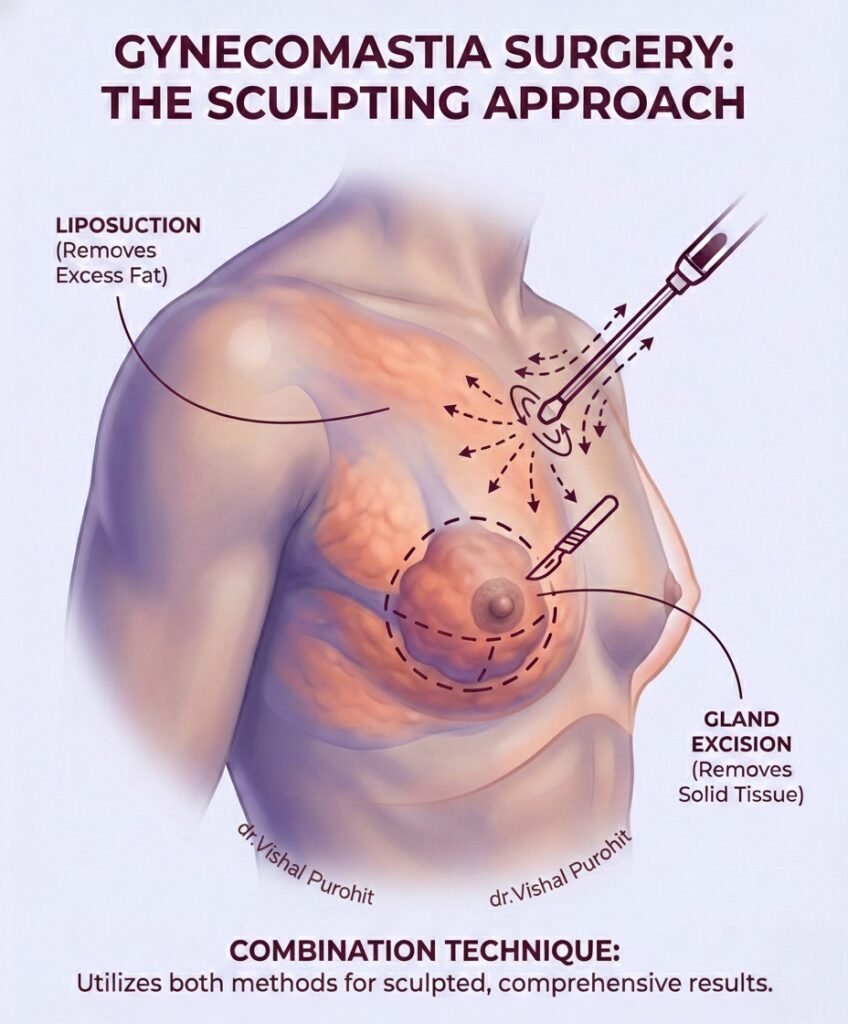
Minimally Invasive Gynecomastia Surgery
- Indication: Suitable for mild to moderate gynecomastia.
- Procedure: Involves slightly smaller incisions than excision but is an equally invasive technique requiring similar dissection. Long procedure times due to limited tissue access.
- Recovery: Varies based on the extent of the surgery and grade of the gland.
| Surgical Technique | Indication | Procedure | Recovery |
|---|---|---|---|
| Liposuction-Assisted | Excessive fatty tissue, Pseudogynecomastia. | Removal of fat via liposuction | Simpler, Quicker, minimal scarring |
| Excisional | Glandular breast tissue and excess skin | Glandular tissue excision, skin removal | Longer, more invasive |
| Combination | Both fat and glandular tissue | Liposuction and excision combined | Varies by surgery extent |
| Minimally Invasive | Mild to moderate gynecomastia | Slightly Smaller incisions | Varies by surgery extent |
The choice of procedure depends upon your prefence and the surgical diagnosis.
The choice of technique is crucial in achieving the best male chest contouring results. You will not be able to decide alone. This makes it essential to consult with an experienced plastic surgeon who can guide you through the process.
In Jaipur, Dr. Vishal Purohit offer these varied types of gynecomastia surgeries, ensuring that each patient receives the best male breast reduction or man boob surgery suited to their specific needs.
Ideal Candidates for Gynecomastia Surgery
Indications for Gynecomastia Surgery
Just remember that gynecomastia is not a disease does not mean it should not be taken care of. This procedure is particularly beneficial for those experiencing pain, tenderness, or social embarrassment due to enlarged breasts.
According to the authors Kasielska and Antoszewski in their study Surgical management of gynecomastia: an outcome analysis, the primary indications of Gynecomastia Surgery include physical discomfort(like pain), psychological distress, and aesthetic concerns.
Determining if you are ready for surgery involves a thorough eligibility and preparation check. This is particularly important for adolescents, where age and timing play a crucial role. We also assess if your condition is related to weight loss or if medical treatment might be a viable first step.
Benefits of Gynecomastia Surgery
The benefits of gynecomastia surgery are multifaceted, significantly impacting the patient’s quality of life.
As concluded by authors Kasielska-Trojan and Antoszewski in their research Gynecomastia Surgery-Impact on Life Quality: A Prospective Case-Control Study, Gynecomastia surgery significantly improved men’s life quality in all aspects and especially in the social aspect and psychical health. This indicates that adult men with gynecomastia are a specific group of patients, in which surgery may result in life quality improvement even over the average scores
At our Clinic, Patients report a newfound sense of confidence and relief from the psychological burden of gynecomastia.
Who is a Suitable Candidate for Gynecomastia Surgery?
You may be suitable if you:
- Have stable weight and overall good health.
- Have persistent chest fullness despite diet and exercise.
- Don’t have untreated hormonal or medication causes.
- Are a non-smoker (or can pause smoking) to support healing.
- Have realistic expectations about scars and recovery.
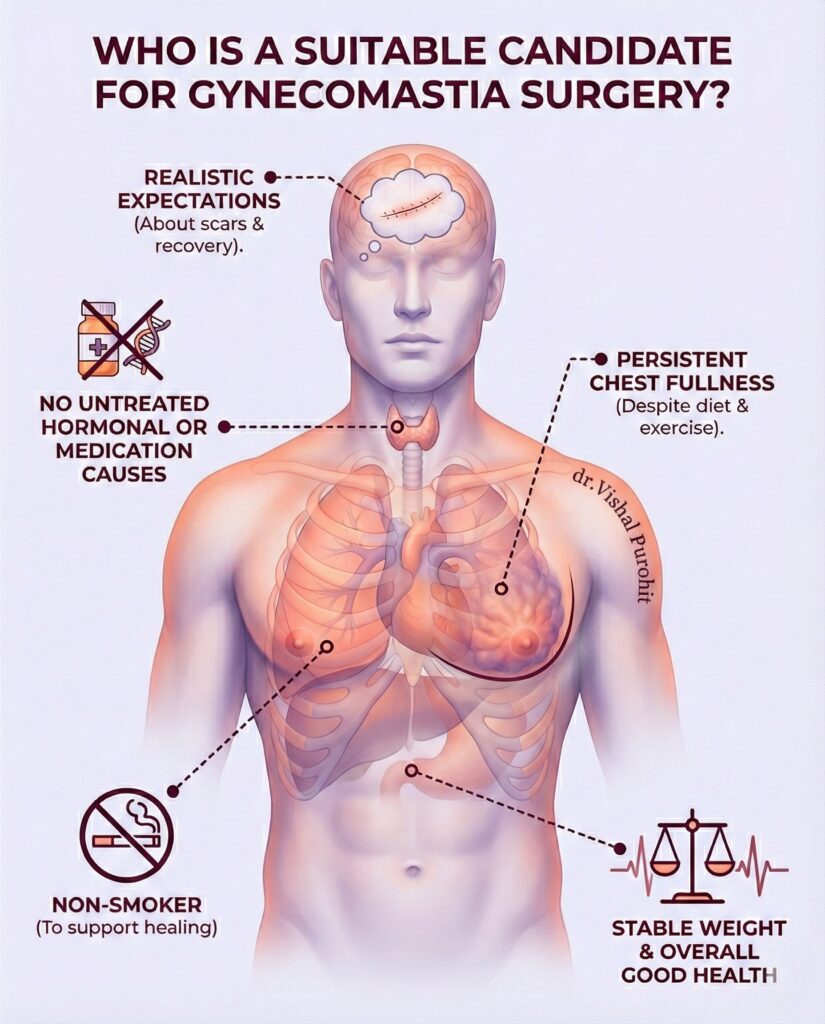
Tip: If your chest feels soft and mainly fatty, you may have pseudogynecomastia—often treated with liposuction alone. If there’s a firm disc under the areola, gland excision is usually needed (often combined with liposuction for best contour).
Authors Noer, H H Søe-Nielsen, N H Gottlieb, J Partoft, S, in their publication Gynecomastia treated by subcutaneous mastectomy, highlight that ideal candidates include individuals with persistent gynecomastia despite medical treatment, those with significant psychological distress, and individuals with stable body weight.
| Criteria | Details |
|---|---|
| Medical History | Absence of treatable medical causes of gynecomastia |
| Psychological Impact | Significant distress or social embarrassment |
| Physical Symptoms | Pain, tenderness, or enlargement not responsive to medical treatment |
| Weight Stability | No major fluctuations, close to ideal body weight |
| Age | Mostly adults; teenagers may be considered if symptoms persist 2 years beyond puberty. |
Preoperative Consultation
Initial Consultation with a Plastic Surgeon
The journey to resolving gynecomastia begins with a comprehensive initial consultation with a skilled Plastic surgeon.
You want a clear understanding of the surgical process and need to set realistic expectations. The consultation is an essential step to discuss the various surgical options, outcomes, and to address any concerns you might have. This interaction forms the basis of the patient-surgeon relationship, ensuring that you are well-informed and comfortable with the planned procedure.
Assessing the Patient’s Goals and Expectations
Understanding the patient’s goals and expectations is a pivotal aspect of the preoperative consultation. As highlighted by authors Rasko, Rosen, Ngaage, et al. in the study Surgical Management of Gynecomastia: A Review of the Current Insurance Coverage Criteria, this assessment helps in tailoring the surgical approach to meet the individual’s desired outcomes. It is essential that the patient’s expectations align with what is surgically feasible and realistic, ensuring satisfaction with the final results.
Medical History and Physical Examination
A thorough medical history and physical examination are integral components of the preoperative assessment. This process involves:
- Review of Medical History: Including any past surgeries, current medications, and overall health status.
- Physical Examination: Assessing the breast tissue to determine the type of gynecomastia and the extent of surgery required.
- Diagnostic Tests: Such as blood tests or imaging studies, if necessary, to rule out underlying causes.
- Discussion of Risks and Benefits: Providing comprehensive information on the potential risks, complications, and benefits of the surgery.
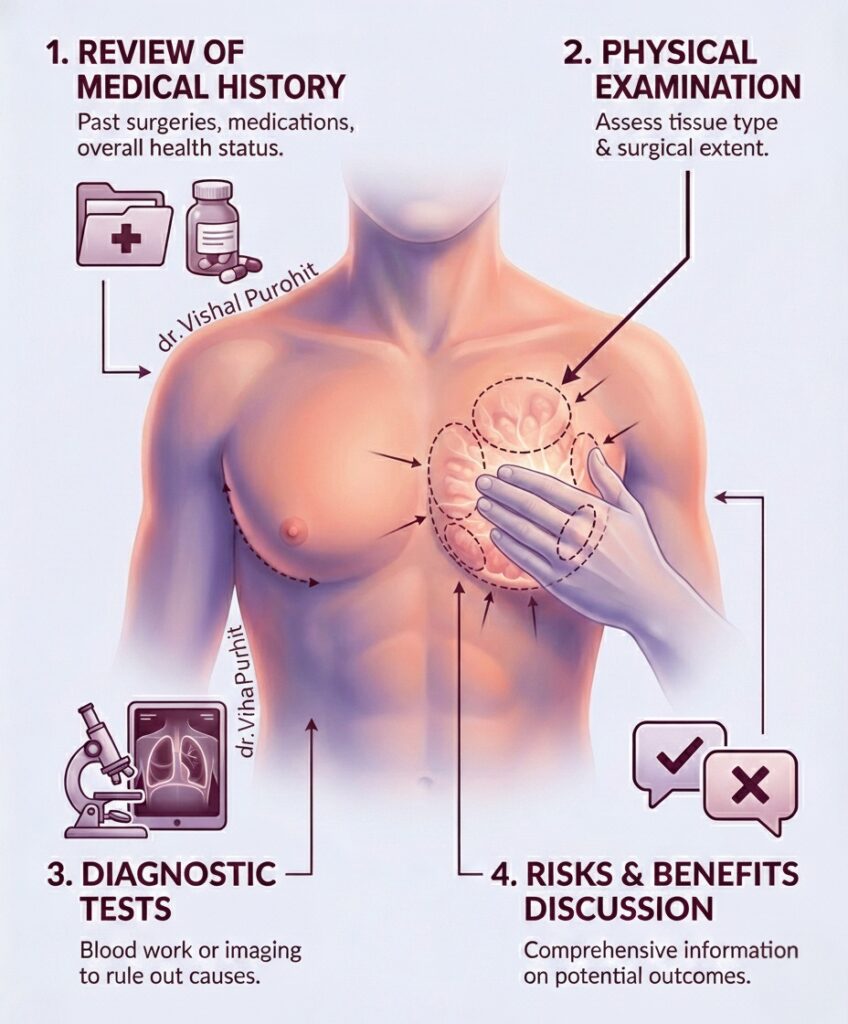
| Assessment Component | Details |
|---|---|
| Medical History Review | Past surgeries, medications, health conditions |
| Physical Examination | Type and extent of gynecomastia |
| Diagnostic Tests | Blood tests, imaging if needed |
| Risk-Benefit Analysis | Informed discussion on surgical risks and benefits |
In Jaipur, Dr. Vishal Purohit’s expertise in gynecomastia surgery ensures that each patient’s preoperative consultation is thorough and personalised. This approach not only prepares the patient for the best male breast reduction surgery but also ensures that the entire process aligns with the patient’s expectations and medical needs.
Preparing for Gynecomastia Surgery
Medical Evaluation
Before undergoing gynecomastia surgery, a thorough medical evaluation is essential. This includes a detailed physical examination to assess the extent of gynecomastia and determine the most suitable surgical approach. According to authors Yang, Mu, Xu, Li, Zhang, et al. in their study Endoscopic subcutaneous mastectomy plus liposuction, a comprehensive evaluation is crucial in planning effective surgical treatment, ensuring both safety and optimal aesthetic outcomes. This assessment helps in tailoring the procedure to the individual’s specific condition, thereby enhancing the chances of successful results.
Medications to Avoid
Prior to gynecomastia surgery, certain medications and supplements that can increase the risk of bleeding or interfere with anaesthesia must be avoided. These include:
- Blood thinners such as aspirin and warfarin.
- Non-steroidal anti-inflammatory drugs (NSAIDs) like ibuprofen.
- Certain herbal supplements and vitamins may affect bleeding and healing.
- Any medication that the surgeon specifically advises against.
Preoperative Instructions
Preoperative instructions are critical for ensuring a smooth surgical experience and optimal recovery. As highlighted by Fischer, Hirsch, Hirche, et al. in their paper Surgical treatment of primary gynecomastia in children and adolescents, patients are advised to follow specific guidelines to prepare for surgery. These instructions often include:
- Fasting guidelines: Avoiding food and drink for a certain period before surgery.
- Hygiene: Showering with antibacterial soap on the day of surgery.
- Clothing: Wearing loose, comfortable clothing on the day of surgery.
- Arrangements: Ensuring someone is available to drive the patient home post-surgery.
| Preparation Aspect | Details |
|---|---|
| Medical Evaluation | Comprehensive physical examination and health assessment |
| Medications to Avoid | Blood thinners, NSAIDs, certain supplements |
| Preoperative Instructions | Blood thinners, NSAIDs, and certain supplements |
Dr. Vishal Purohit’s meticulous approach to preparing patients for gynecomastia surgery in Jaipur involves careful medical evaluation, clear guidance on medications to avoid, and thorough preoperative instructions. This comprehensive preparation is key to achieving the best male breast reduction and man boob surgery results, with a focus on patient safety and satisfaction.
The Surgical Procedure
Tailoring Gynecomastia Surgery to Individual Needs
Gynecomastia surgery, or male breast reduction, must be carefully tailored to each patient’s unique needs and conditions. This involves evaluating the extent of breast enlargement, the composition of breast tissue (fatty vs. glandular), and the patient’s overall health and aesthetic goals. The surgical approach is customised based on these factors, ensuring the best male chest contouring results in Jaipur.
Discussing Options with the Patient
A critical step in the surgical process is discussing the various treatment options with the patient. This discussion includes explaining the differences between liposuction-assisted surgery and excisional surgery, and in some cases, a combination of both. The patient’s input is vital in this decision-making process, as it helps in aligning the surgical plan with the patient’s expectations for the best gynecomastia surgery outcome.
Anesthesia Options
Anaesthesia plays a crucial role in gynecomastia surgery, ensuring patient comfort and safety throughout the procedure. Local anaesthesia with sedation is commonly used in gynecomastia surgeries, providing adequate pain control while allowing for a quicker recovery post-surgery. General anaesthesia is equally effective and often used in more apprehensive patients.
Surgical Technique Steps
The surgical technique for gynecomastia surgery varies based on the chosen method. As described by Boljanovic, Axelsson, and Elberg in their paper Surgical treatment of gynecomastia: liposuction combined with excision of glandular tissue, the steps typically include:
- Marking the Surgical Area: Identifying the areas of fat and glandular tissue to be addressed.
- Incision: Small incisions are made, usually around the areola or underarm area.
- Liposuction: If necessary, liposuction is performed to remove excess fatty tissue.
- Glandular Tissue Excision: Removal of excess glandular tissue for cases with prominent glandular enlargement.
- Contouring: Adjusting the chest contour for a more natural, masculine chest appearance.
- Closure: The incisions are closed with sutures.
- Recovery: Post-operative care instructions are provided to ensure proper healing and optimal results.
| Step | Description |
|---|---|
| Marking | Identifying surgical areas |
| Incision | Making strategic cuts for access |
| Liposuction | Removing excess fat |
| Excision | Removing glandular tissue |
| Contouring | Shaping the chest area |
| Closure | Suturing incisions |
| Recovery | Post-operative care guidelines |
In Jaipur, Dr. Vishal Purohit, a renowned plastic surgeon, employs these meticulous surgical techniques, ensuring each patient receives the best man boob surgery or male breast reduction tailored to their specific needs. The focus on individualised care and precise surgical execution underlines his commitment to delivering the best gynecomastia surgery in Jaipur.
Recovery Period
Most patients return to work within 48 hours. However, for a detailed breakdown of gym restrictions and healing phases, please read our full Recovery Timeline Guide.
Immediate Post-Op Care and Management
The immediate post-operative care following gynecomastia surgery is vital for a smooth recovery and optimal results. Close monitoring in the initial hours post-surgery is crucial. This involves regular checks of vital signs, managing any immediate discomfort, and ensuring the surgical site is healing properly. The first few hours are critical in setting the tone for the recovery phase.
Pain Management
Effective pain management is a key aspect of the recovery process after gynecomastia surgery. As outlined by Kim, Byun, Lee, Won Jai Rah, et al., in their research Surgical Management of Gynecomastia: Subcutaneous Mastectomy and Liposuction, a combination of prescribed pain medication and careful monitoring is employed to manage post-operative discomfort. This approach helps in minimising pain, ensuring patient comfort, and facilitating a smoother recovery.
Expected Recovery Timeline
The recovery timeline for gynecomastia surgery can vary depending on the extent of the surgery and the individual patient’s healing process. As observed by Steele, Martin, and Place in their article Gynecomastia: complications of the subcutaneous mastectomy, patients typically experience a significant reduction in swelling and discomfort within the first few weeks. Most patients are able to return to normal activities within a few days to a week, with full recovery taking several weeks to a few months.
Detailed Post-Op Instructions
Post-operative instructions are crucial for a successful recovery. These typically include:
- Activity Restrictions: Avoiding strenuous activities and heavy lifting for a specified period. All movement at the shoulder joints is restricted for the first few days.
- Wound Care: Instructions on how to care for the surgical site and drains, if any.
- Compression Garments: Wearing compression garments to reduce swelling and support the new chest contour.
- Follow-Up Appointments: Regular check-ups to monitor healing and address any concerns.
- Signs of Complications: Information on what symptoms to watch for that could indicate complications.
| Recovery Aspect | Details |
|---|---|
| Post-Op Care | Vital sign monitoring, managing discomfort |
| Pain Management | Prescribed medications, monitoring |
| Recovery Timeline | Return to activities in days/weeks, full recovery in weeks/months |
| Post-Op Instructions | Activity restrictions, wound care, compression garments, follow-up appointments |
In Jaipur, under the expert care of Dr. Vishal Purohit, patients undergoing gynecomastia surgery receive comprehensive post-op care and instructions, ensuring the best male breast reduction results with a focus on patient safety and comfort.
Risks and Complications
While complications are rare, we believe in total transparency regarding safety and risks. Our protocols are designed to minimise issues like hematoma or seroma.
Common Side Effects
Gynecomastia surgery, like any surgical procedure, has its share of common side effects. As noted by Cianchetti, Legnini, Ucchino, Ricci, et al., in their article Gynecomastia, patients may experience swelling, bruising, and discomfort in the chest area post-surgery. These side effects are typically temporary and gradually subside as the healing process progresses. It’s important for patients to be aware of these common occurrences to better prepare for the recovery phase.
Rare Complications
While gynecomastia surgery is generally safe, there are rare complications that can arise. According to Zavlin, Jubbal, Friedman, et al., in their commentary Comment to: “Complications and Outcomes After Gynecomastia Surgery”, complications such as hematoma, seroma, infection, and irregularities in chest contour can occur, albeit infrequently. These complications require prompt medical attention to manage effectively.
Steps to Minimise Risks
To minimise the risks associated with gynecomastia surgery, several steps are taken:
- Preoperative Assessment: Comprehensive evaluation to identify any potential risk factors.
- Surgical Technique: Utilizing precise and proven surgical methods to reduce complication rates.
- Postoperative Care: Adhering to postoperative instructions and regular follow-ups for early detection of any issues.
Management of Complications
In case of any complications, the following steps are crucial for effective management:
- Immediate Medical Attention: Seeking prompt medical care if any signs of complications arise.
- Follow-up Appointments: Regular check-ups for monitoring and timely intervention.
- Medications and Treatments: Use of appropriate medications or additional treatments if needed.
| Aspect | Details |
|---|---|
| Common Side Effects | Swelling, bruising, discomfort |
| Rare Complications | Hematoma, infection, contour irregularities |
| Risk Minimization | Preoperative assessment, precise surgical techniques, postoperative care |
| Complication Management | Prompt medical attention, regular follow-ups, appropriate treatments |
Under the skilled care of Dr. Vishal Purohit in Jaipur, patients undergoing gynecomastia surgery are provided with comprehensive guidance on managing risks and complications. His approach ensures the best male breast reduction outcomes while prioritizing patient safety and well-being.
Results and Expectations
Our advanced techniques ensure that the results are permanent, provided weight is maintained. Furthermore, we place incisions strategically to ensure scars remain invisible and hidden within the natural contours.
Timeline for Seeing Final Results
The timeline for seeing the final results after gynecomastia surgery varies depending on the extent of the surgery and individual healing processes. Generally, patients can start to notice a significant improvement in the shape and appearance of their chest within a few weeks post-surgery. However, it can take several months for the final results to fully manifest as swelling subsides and the area heals completely.
Realistic Expectations
Setting realistic expectations is crucial for patient satisfaction following gynecomastia surgery. While the surgery effectively reduces breast size and improves chest contour, patients should understand that it might not achieve perfection. Factors such as skin elasticity, body shape, and individual healing responses play a significant role in the final outcome. Communication with the surgeon about anticipated results is key to aligning expectations with realistic outcomes.
Maintaining the Results
Maintaining the results of gynecomastia surgery involves a commitment to a healthy lifestyle. This includes maintaining a stable weight, as significant weight gain or loss can affect the surgery’s outcome. Regular exercise and a balanced diet are recommended to keep the chest area well-contoured and to prevent recurrence of gynecomastia.
Secondary Surgical Options to Improve Results
In some cases, secondary surgical options might be considered to improve or refine the results of the initial gynecomastia surgery. According to R.L. Dolsky in the study Gynecomastia Treatment by liposuction subcutaneous mastectomy, secondary procedures may be necessary for optimal aesthetic outcomes, especially in cases of significant skin laxity or asymmetry post-surgery. These options should be discussed thoroughly with the surgeon to understand the benefits and additional risks involved.
| Aspect | Details |
|---|---|
| Final Results Timeline | Weeks to months post-surgery |
| Realistic Expectations | Effective reduction and improvement, not perfection |
| Maintaining Results | Healthy lifestyle, stable weight, regular exercise |
| Secondary Options | For refinement or addressing specific issues |
In Jaipur, Dr. Vishal Purohit ensures that his patients have a clear understanding of what to expect from their gynecomastia surgery, including the timeline for results and the importance of maintaining them. His expertise in male breast reduction and man boob surgery is complemented by his commitment to patient education and postoperative care.
Cost of Gynecomastia Surgery in Jaipur
The final price depends on the grade and technique used. For a detailed breakdown of the packages, please view our Transparent Pricing Guide.
Factors Affecting the Cost of Gynecomastia Surgery
The cost of gynecomastia surgery in Jaipur can vary widely between ₹45,000 to ₹80,000 based on several factors. Understanding these factors can help patients better prepare for the financial aspects of their surgery:
- Surgeon’s Expertise: The experience and reputation of the plastic surgeon play a significant role in determining the cost. Surgeons like Dr. Vishal Purohit, known for their expertise, may charge more due to their high demand and proven track record.
- Surgical Technique: The complexity of the surgical technique required for individual cases affects the cost. Advanced techniques or combination procedures (liposuction and excision) can increase the price.
- Facility Fees: The cost of the facility where the surgery is performed also contributes to the overall cost. High-end facilities with state-of-the-art equipment may charge more.
- Anaesthesia Fees: The type and duration of anaesthesia used during the surgery will affect the total cost.
- Geographical Location: The location of the clinic in Jaipur can influence the cost, with central, more accessible locations potentially being more expensive.
- Additional Costs: Post-surgery garments, medication, and follow-up visits may add to the total expense.
Financing Options and Insurance
Understanding the financing options and insurance coverage for gynecomastia surgery is essential for patients.
- Health Insurance: In some cases, if gynecomastia surgery is deemed medically necessary (such as in severe cases causing pain or restriction), it may be partially covered by health insurance. Patients should consult their insurance provider for detailed information.
- Financing Plans: Many clinics offer financing plans to help patients manage the cost of surgery. These plans may include flexible payment options or instalment plans to make the surgery more affordable.
- Savings and Personal Loans: Patients may also consider using personal savings or taking out a personal loan to cover the cost of the surgery.
- Medical Credit Cards: Specific credit cards designed for medical expenses can also be an option, offering special financing terms.
| Cost Factor | Details |
|---|---|
| Surgeon’s Expertise | Experience and reputation of the surgeon |
| Surgical Technique | Complexity and type of procedure |
| Facility Fees | Cost of the surgical facility |
| Anesthesia Fees | Type and duration of anesthesia |
| Geographical Location | Location of the clinic in Jaipur |
| Additional Costs | Post-surgery care and follow-ups |
It’s important for patients in Jaipur considering gynecomastia surgery to consult with clinics like Dr. Vishal Purohit’s to get an accurate estimate of the costs involved, including the best gynecomastia surgery cost in Jaipur and available financing options. This ensures that patients can make informed decisions about their surgery and its financial implications.
Alternatives to Gynecomastia Surgery
Non-Surgical Options
For those seeking alternatives to surgical intervention for gynecomastia, there are several non-surgical options available:
- Hormonal Therapy: In cases where gynecomastia is due to hormonal imbalances, medications to adjust hormone levels may be effective.
- Fat Reduction Techniques: Non-invasive fat reduction treatments like CoolSculpting can help reduce the appearance of enlarged breasts, particularly if the condition is primarily due to fatty tissue like pseudo-gynecomastia.
- Diet and Exercise: Adopting a healthy diet and regular exercise regime can help reduce body fat, including in the breast area, though it may not fully resolve glandular gynecomastia.
- Compression Garments: Wearing specialized compression garments can temporarily reduce the appearance of enlarged breasts.
Surgical Options
Apart from the traditional surgical methods for treating gynecomastia, other surgical alternatives exist. According to Mohamad Hasan and Riyadh in their study Modified Benelli procedure for subcutaneous mastectomy in gynecomastia, techniques such as the Modified Benelli procedure can be effective. This method is less invasive and may be suitable for certain cases of gynecomastia, offering a different approach to the standard excision or liposuction methods.
| Option Type | Alternatives |
|---|---|
| Non-Surgical | Hormonal therapy, fat reduction techniques, diet and exercise, compression garments |
| Surgical | Modified Benelli procedure, other less invasive surgical techniques |
Patients in Jaipur considering treatment for gynecomastia should discuss all available options, both surgical and non-surgical, with a qualified professional like Dr. Vishal Purohit. This ensures a comprehensive understanding of the treatments available for the best male chest contouring and male breast reduction results.
Combining Gynecomastia Surgery with Other Cosmetic Surgeries
Combining gynecomastia surgery with other cosmetic procedures can be an effective way for patients to achieve a more comprehensive transformation and to address multiple aesthetic concerns in one surgical session. This approach is becoming increasingly popular as it offers several benefits, including a single recovery period and potentially reduced overall costs. However, it’s important to carefully consider the individual’s overall health, the extent of the surgeries, and the potential risks involved.
According to Xu, Boyang; Mu, Dali; Yang, Yan; Liu, Tong in their study Endoscopic Axillary Approach Improves Patient Satisfaction in Gynecomastia Surgery, combining gynecomastia surgery with other procedures such as liposuction or abdominoplasty can enhance patient satisfaction and outcomes. This is particularly beneficial for patients looking to achieve a more contoured and balanced body appearance.
When considering combining gynecomastia surgery with other cosmetic surgeries, it’s important to discuss the following factors with a qualified plastic surgeon:
- Overall Health Assessment: Ensure that the patient is in good health and can safely undergo multiple procedures.
- Surgical Plan and Techniques: Discuss how the surgeries will be combined and what techniques will be used.
- Recovery and Downtime: Understand the recovery process, as combining surgeries may lead to a longer recovery period.
- Risks and Complications: Be aware of the potential risks associated with multiple procedures.
- Cost Implications: Consider the financial aspects of combining surgeries, including any potential cost savings.
In Jaipur, surgeons like Dr. Vishal Purohit are experienced in performing combined cosmetic surgeries, offering patients the convenience and benefits of addressing multiple concerns in one surgical session. This approach to gynecomastia surgery and other cosmetic procedures ensures that patients receive comprehensive care tailored to their unique aesthetic goals.
Psychological Impact of Gynecomastia Surgery
Psychological Considerations Before Surgery
The decision to undergo gynecomastia surgery often involves significant psychological considerations. For many individuals, enlarged breasts can lead to feelings of self-consciousness, embarrassment, and social withdrawal. Prior to surgery, it is not uncommon for patients to experience a range of emotions, including anxiety about the procedure’s outcome and concerns about societal perceptions. Plastic surgeons must address these emotional aspects, providing reassurance and setting realistic expectations to ease any psychological distress.
Psychological Benefits of the Surgery
The psychological benefits of gynecomastia surgery can be profound. According to Mordcai Blau and Ron Hazani in their study Correction of gynecomastia in body builders and patients with good physique, patients often experience a significant improvement in self-esteem and body image following the surgery. This improvement in psychological well-being can lead to enhanced social interactions, increased participation in physical activities, and an overall better quality of life. The removal of the psychological burden of gynecomastia often marks a turning point, allowing individuals to regain confidence and feel more comfortable in their skin.
In Jaipur, surgeons like Dr. Vishal Purohit understand the importance of addressing both the physical and psychological aspects of gynecomastia. They ensure that patients are fully informed and mentally prepared for the surgery, thus enhancing the overall positive impact of the procedure. The psychological benefits, combined with the physical improvements, make gynecomastia surgery a transformative experience for many.
Frequently Asked Questions About Gynecomastia Surgery
What is Gynecomastia Surgery?
Gynecomastia surgery, also known as male breast reduction, is a procedure to reduce enlarged or overdeveloped breasts in men. This surgery can involve liposuction, excision of glandular tissue, or a combination of both, depending on the nature of the gynecomastia.
Who is the Ideal Candidate for Gynecomastia Surgery?
Ideal candidates are those experiencing physical discomfort, psychological distress due to enlarged breasts, and have not seen improvement through other treatments. Stable body weight and good health are also important factors.
What are the Different Types of Gynecomastia Surgery?
The primary types include liposuction-assisted surgery (for excess fatty tissue) and excisional surgery (for glandular breast tissue or excess skin). Sometimes, a combination of both techniques is used.
How Long Does Gynecomastia Surgery Take?
The duration of gynecomastia surgery varies but generally takes 1-3 hours. The exact time depends on the complexity of the surgery and the techniques used.
Is Gynecomastia Surgery Painful?
Patients typically experience some discomfort after surgery, which is manageable with prescribed pain medication. The level of pain varies depending on the individual’s pain threshold and the extent of the surgery.
What is the Recovery Time After Gynecomastia Surgery?
Recovery time varies; however, most patients return to normal activities within a few days to a week. Complete recovery, including the subsiding of swelling and healing of incisions, can take several weeks to a few months.
Are There Any Risks or Complications Associated with Gynecomastia Surgery?
Like any surgery, gynecomastia surgery carries risks, including infection, hematoma, and irregularities in chest contour. However, these complications are rare and can be managed effectively.
How Long Do the Results of Gynecomastia Surgery Last?
The results of gynecomastia surgery are typically long-lasting, especially if the patient maintains a stable weight and follows a healthy lifestyle. Hormonal fluctuations or significant weight gain can affect the results.
Will There Be Scars After Gynecomastia Surgery?
Scarring is a natural outcome of surgery. However, surgeons aim to minimize and strategically place incisions to reduce the visibility of scars. Over time, these scars usually fade significantly.
How Much Does Gynecomastia Surgery Cost in Jaipur?
The cost of gynecomastia surgery in Jaipur varies based on factors such as the surgeon’s expertise, surgical technique used, and facility fees. It’s best to consult with a clinic or surgeon for a detailed cost estimate based on individual needs.
Glossary: Terms Related to Gynecomastia Surgery
| Term | Definition |
|---|---|
| Gynecomastia | A medical condition characterized by the enlargement of breast tissue in males, often caused by hormonal imbalances, obesity, or certain medications. |
| Liposuction | A surgical technique used to remove excess fat from the body, commonly employed in gynecomastia surgery to address fatty breast tissue. |
| Excision | The surgical removal of tissue. In the context of gynecomastia surgery, this refers to the removal of excess glandular breast tissue. |
| Mastectomy | Surgical removal of breast tissue. In gynecomastia, this term often refers to subcutaneous mastectomy, where only the breast tissue is removed, not the entire breast. |
| Anesthesia | Medication used during surgery to relieve pain and alter consciousness. In gynecomastia surgery, local or general anesthesia may be used. |
| Compression Garment | A specialized garment worn after surgery to reduce swelling, provide support, and help shape the operated area. |
| Hematoma | A collection of blood outside blood vessels, often occurring as a complication of surgery. |
| Postoperative Care | The care and treatment provided after surgery, including wound care, pain management, and follow-up appointments. |
| Chest Contouring | The process of reshaping the chest area to achieve a more aesthetically pleasing and masculine appearance, often a goal of gynecomastia surgery. |
| Psychological Distress | Emotional and mental discomfort experienced by individuals with gynecomastia, often due to social stigma or self-consciousness about their appearance. |
This glossary provides key terms related to gynecomastia surgery, helping individuals in Jaipur and beyond to better understand the procedure, its implications, and the recovery process.
Signing off
In summary, this comprehensive guide has explored various aspects of gynecomastia surgery, a transformative procedure for men struggling with enlarged breast tissue. We have delved into the surgery’s definition, types, candidacy, preparation, procedure, recovery, risks, and expected outcomes. Additionally, we discussed cost considerations, alternatives, and the significant psychological impact of this surgery.
Ultimately, the procedure offers a profound physical and psychological transformation, restoring your confidence to go shirtless again.
For those in Jaipur seeking expert advice and quality care in gynecomastia surgery, Dr. Vishal Purohit stands as a leading figure in this field. With his extensive experience, Dr. Purohit offers personalized solutions, ensuring the best possible outcomes for each patient.
Call to Action: If you or someone you know is considering gynecomastia surgery and would like more information, or to discuss your options, please feel free to call or contact via WhatsApp or Telegram at +91-7718183535.
Disclaimer: This article is intended for informational purposes only and should not be considered as medical advice. Each individual’s case is unique, and it is important to consult with a qualified healthcare professional like Dr. Vishal Purohit for personalized advice and treatment options. For consultation and more details, you can visit Dr. Vishal Purohit’s clinic at the location provided in this Google Maps link.


